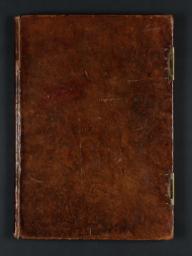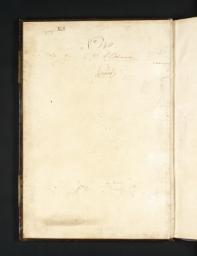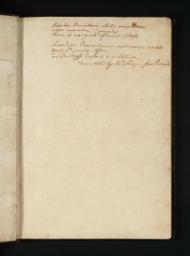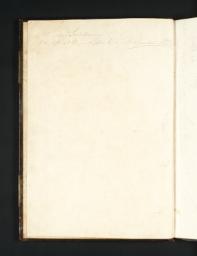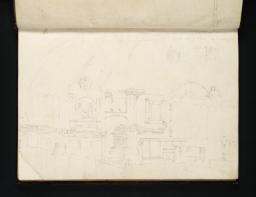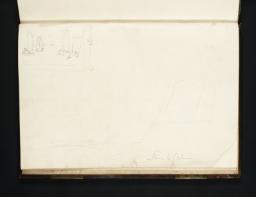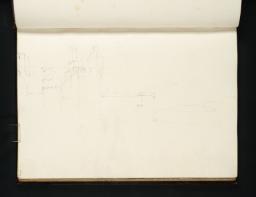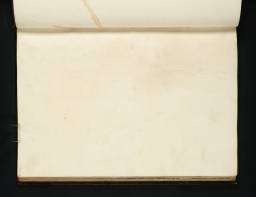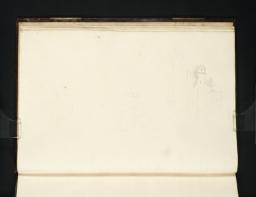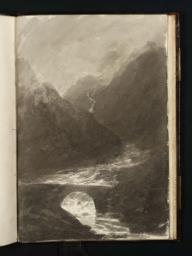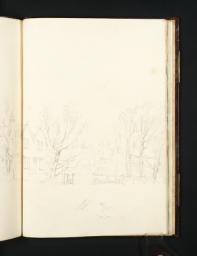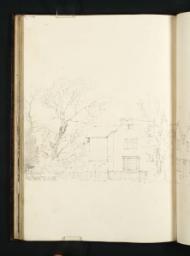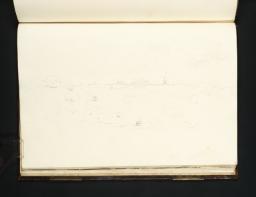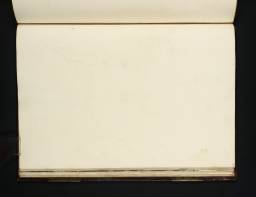Turner Bequest XLV 1–50
Sketchbook bound in boards covered in calf leather, with two brass clasps (broken)
54 leaves of white wove paper; page size 329 x 225 mm; watermarks ‘1794 | J Whatman’ and ‘97’
Inscribed by Turner in brush and black ink ‘Lancashire | North Wales’ on front cover (D41266)
Numbered 140 as part of the Turner Schedule in 1854, and endorsed by the Executors of the Turner Bequest inside front cover (D41267)
54 leaves of white wove paper; page size 329 x 225 mm; watermarks ‘1794 | J Whatman’ and ‘97’
Inscribed by Turner in brush and black ink ‘Lancashire | North Wales’ on front cover (D41266)
Numbered 140 as part of the Turner Schedule in 1854, and endorsed by the Executors of the Turner Bequest inside front cover (D41267)
Exhibition history
References
This sketchbook accompanied Turner on his visit to North Wales in 1799; he evidently felt that the scenery of Snowdonia which he had begun to explore in the previous year required more attention, and he took with him some much larger sheets of paper on which to make watercolour drawings of the high mountains on the spot; see the associated subsection of this catalogue. The book is of generous dimensions, and a few pages are devoted to powerful monochrome mountain subjects.
This year, Turner crossed the Menai Strait to visit Beaumaris Castle, which he had omitted from his previous tour; see folios 2 recto and 3 recto (D01913, D01914). Returning across the Strait he made several drawings of Caernarvon, of which he had already gathered enough information to produce a large watercolour, shown at the Royal Academy this year (private collection).1 He clearly found the structure an irresistible subject. Begun in 1383 by Edward I, it was famous for the beauty of its Crusader-inspired architecture; it became for Turner a symbol of the Edwardian conquest of Wales in the thirteenth century, and he made it the focus of another ambitious watercolour, shown at the Academy in 1800, in which the castle provides the backdrop to a poignant scene from (imaginary) medieval Welsh history (Tate D04164; Turner Bequest LXX M).2
Thanks to the dimensions of the book, should Turner have availed himself of a double spread he had a sizeable area of paper to hand. Oddly, this occurs only once, on folios 14 verso–15 recto (D01928–D01929), and his subject is not a mountain panorama (perhaps because he had equipped himself with large sheets for just such purposes) but a house – that of the Rev. Thomas Dunham Whitaker (1759–1821), who had commissioned a series of views of places of interest in Lancashire, for a projected volume which was published in 1800–1 under the title History of the Original Parish of Whalley and Honour of Clitheroe. Ten watercolour designs by Turner (various collections)3 were engraved by James Basire (Tate impressions: T05926–T05934).
Turner had already enjoyed the patronage of Yorkshire landowners, notably the Lascelles family of Harewood (see the ‘North of England 1797–1801’ section, particularly the group of ‘Drawings Made at Harewood and Plompton Rocks’). Here for the first time in the sketchbooks (on the verso of the front flyleaf, D41269) we encounter the name of Edward Swinburne (1762–1860), of Capheaton Hall, County Durham, who became a pupil of Turner’s about now, and whose family were neighbours of Walter Fawkes of Farnley Hall, near Otley, in Yorkshire; it was probably through these Yorkshire connections that the artist came to know Fawkes (1769–1825), whose friendship and patronage was to be so important an element in his life and career. Charles Townley (1737–1805) of Towneley Hall (sic), Burnley, was another patron in this group, whose house is recorded here on folio 46 recto (D01985; Turner Bequest XLV 45).
Another important local collector was Thomas Lister Parker (1769–1858) of Browsholme Hall, the subject of another plate in the History of Whalley (Tate impression: T05931). Turner’s initial drawing of it was probably also made in this book, though it is no longer in place and may have been destroyed; the finished watercolour is in a private collection.4 Opposite Whitaker’s home at The Holme rise the cliffs of Cliviger Gorge, and Turner made a few slight sketches in this book to record this unusual geological formation, on the versos of folios 37, 38, 39 and 40 (D01972, D01974, D01976, D01978). He was to execute more watercolours for Whitaker (various collections)5 when he was commissioned to illustrate his History of Richmondshire, published between 1819 and 1823 (Tate impressions: T04439–T04484); see David Hill’s ‘Tour of Yorkshire 1816’ section in the present catalogue.
Uncertainty as to the significance of an inscription on folio 28 recto (D01954) means that the overall dating of the sketchbook’s use has been extended from 1799 to 1799–1801.
Technical notes
Finberg noted a considerable number of leaves cut or torn out:
six ‘cut out’ between the verso of the front flyleaf and folio 1 recto (D41269, D01912)6
three ‘torn out’ between folio 1 verso and folio 2 recto (D41270, D01913)7
one ‘torn out’ between folios 4 and 5 (D01915, D01916)8
six ‘out’ between folios 5 verso and 6 recto (D01917, D01918)9
two ‘out’ between folios 9 and 10 (D01922, D01923)10
one ‘torn out’ between folios 12 and 13 (D01925, D01926)11
two ‘torn out’ between folios 13 and 14 (D01926, D01927)12
one ‘torn out’ between folios 30 verso and 31 recto (D01959, D01960)13
one ‘torn out’ between folios 40 verso and 41 recto (D01978, D01979)14
three ‘torn out’ between folio 1 verso and folio 2 recto (D41270, D01913)7
one ‘torn out’ between folios 4 and 5 (D01915, D01916)8
six ‘out’ between folios 5 verso and 6 recto (D01917, D01918)9
two ‘out’ between folios 9 and 10 (D01922, D01923)10
one ‘torn out’ between folios 12 and 13 (D01925, D01926)11
two ‘torn out’ between folios 13 and 14 (D01926, D01927)12
one ‘torn out’ between folios 30 verso and 31 recto (D01959, D01960)13
one ‘torn out’ between folios 40 verso and 41 recto (D01978, D01979)14
In addition, there is evidence of a leaf torn out between folios 28 verso and 29 recto (D01955, D01956). Folio 42 (D01981) is a blank leaf, not recorded by Finberg.15 He listed the subsequent nine pages (and also a duplication of XLV 49, listed as ‘XLV 51’; see under D01989) as ‘Loose Leaves’.16 Some were apparently removed by Turner himself for reference in the studio, and have sustained some damage; others were extracted by John Ruskin for exhibition, and their paper is discoloured. All were rebound into the book in Finberg’s numbered order with no apparent regard to their likely place in the original sequence.
Like the Turner Bequest Executors, in cataloguing the sketchbook Finberg assumed that Turner’s inscription on the cover (D41266), ‘Lancashire | North Wales’ and various notes on the present front flyleaf (D41268, D41269), denoted the front. In fact most of the subjects are landscapes, drawn with the page turned horizontally, but where a view is upright it is inverted according to this ordering, suggesting that Turner actually used the book in reverse order, starting at what is now foliated as the back.
A concordance follows from the point where the folio and Turner Bequest numbers diverge.
| Folio | Tate | Turner Bequest |
| 41 Recto | D01979 | XLV 41 |
| 41 Verso: | D01980 | XLV 41a |
| 42 Recto: | D01981 | XLV 41b |
| 43 Recto | D01982 | XLV 42 |
| 43 Verso: | D41271 | - |
| 44 Recto | D01983 | XLV 43 |
| 44 Verso: | D41272 | - |
| 45 Recto | D01984 | XLV 44 |
| 46 Recto: | D01985 | XLV 45 |
| 47 Recto | D01986 | XLV 46 |
| 47 Verso: | D41273 | - |
| 48 Recto | D01987 | XLV 47 |
| 49 Recto | D01988 | XLV 48 |
| 49 Verso: | D41274 | - |
| 50 Recto: | D01989 | XLV 49 |
| 51 Recto | D01990 | XLV 50 |
At the back of the book are two blank flyleaves. The second is inscribed by a later hand in pencil ‘2’ on its verso, and both bear the partial watermark ‘97’. As this suggests, these leaves are of a different paper from either of the two types found in the rest of the book. The inside of the back cover is blank.
How to cite
Andrew Wilton, ‘Lancashire and North Wales Sketchbook 1799–1801’, sketchbook, May 2013, in David Blayney Brown (ed.), J.M.W. Turner: Sketchbooks, Drawings and Watercolours, Tate Research Publication, April 2016, https://www

